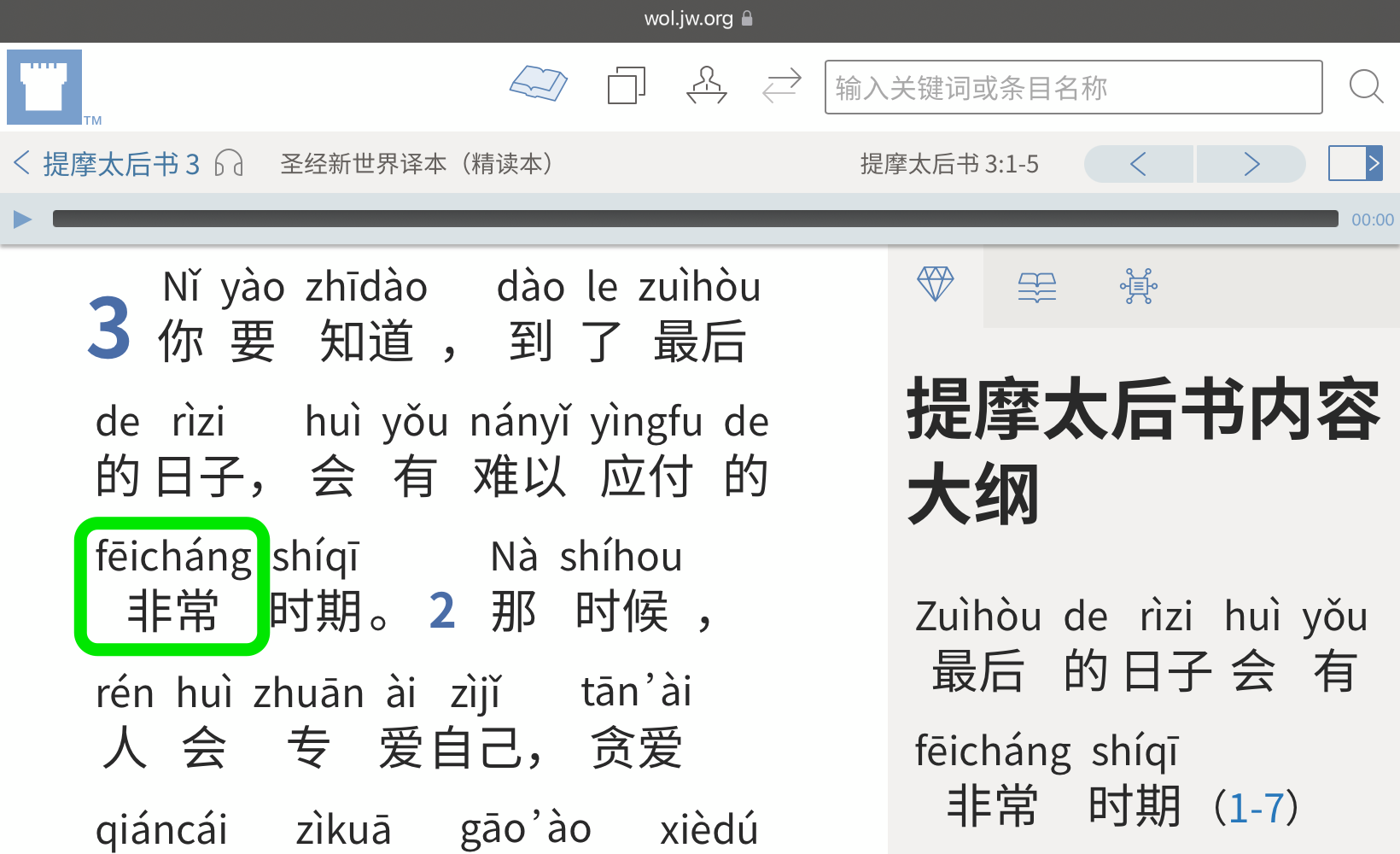fēicháng (fēi·cháng un·usual/common/ordinary | un·usually/commonly [→ [very [much]; extremely; highly]] 非常) ← Tap/click to show/hide the “flashcard”
“Fēicháng (Fēi·cháng un·usual/common/ordinary | un·usually/commonly [→ [very [much]; extremely; highly]] 非常)” was probably one of the first words you learned as a Mandarin field language learner. In fact, one of the first things your Mandarin instructor may have said to you in Mandarin may have been “fēicháng (fēi·cháng un·usually → [very] 非常) hǎo (good 好)!”, if you had just said something well in Mandarin. So, having learned that “fēicháng (fēi·cháng un·usual/common/ordinary | un·usually/commonly [→ [very [much]; extremely; highly]] 非常)” means “very”, you may have been confused when seeing how “fēicháng (fēi·cháng un·usual/common/ordinary | un·usually/commonly [→ [very [much]; extremely; highly]] 非常)” is used in the Mandarin New World Translation Bible at 2 Timothy 3:1:

“Fēicháng shíqī ((Fēi·cháng un·ordinary 非常) (shí·qī {(particular) times} · periods 时期 時期) → [times of emergency])”? The corresponding term that the English NWT Bible uses in this scripture is “critical times”, but this Mandarin translation seems to mean “very times”, which doesn’t make sense. What’s going on here?
Breaking It Down
While especially as our Mandarin learning journeys begin we may want to keep things simple and mentally just have the view that this Mandarin word means that English word, eventually we encounter the more complex reality that Mandarin and English are two very different languages that come from different cultures, and that have different techniques and histories relating to how speech sounds are put together to convey meanings.
To help us get a grip on this sometimes messy reality, let us remember that while phrases and sentences can be broken down into words, words can in turn be broken down into morphemes. This excerpt from the introduction of a Pīnyīn (Pīn·yīn {Piecing Together} · Sounds → [Pinyin] 拼音) Plus resource briefly discusses Mandarin morphemes and how they are handled in Pīnyīn (Pīn·yīn {Piecing Together} · Sounds → [Pinyin] 拼音) Plus material:
As far as is practical, the meaning of each individual Mandarin morpheme (smallest unit of language sound with meaning) is translated literally according to how it is used in the context in which it appears. (In Mandarin, morphemes usually correspond with syllables, but some syllables are sound-only (without meaning) and thus not morphemes, and some morphemes have more than one syllable.)
The morphemes in “fēicháng (fēi·cháng un·usual/common/ordinary | un·usually/commonly [→ [very [much]; extremely; highly]] 非常) ” are:
- “fēi (not; no; non[-]; un[-]; in[-] 非)”
- “cháng (ordinary; common; normal | constant; invariable | often; usually; frequently 常)”
Putting It Together
So, while “fēicháng (fēi·cháng un·usual/common/ordinary | un·usually/commonly [→ [very [much]; extremely; highly]] 非常)” as a whole word is often used to effectively mean “very”, a look at the literal meanings of the morphemes that make it up helps us to understand that it actually literally means “unusually” or “uncommonly” when it is used to effectively mean “very”. In the context of 1 Timothy 3:1, “fēicháng (fēi·cháng un·ordinary 非常)” is used as an adjective meaning “unordinary” or “uncommon”, and it is put together with “shíqī (shí·qī {(particular) times} · periods 时期 時期)” to make up “fēicháng shíqī ((fēi·cháng un·ordinary 非常) (shí·qī {(particular) times} · periods 时期 時期) → [times of emergency])”, an expression that is used to effectively mean “times of emergency”.
Plus
The curious case of “fēicháng (fēi·cháng un·usual/common/ordinary | un·usually/commonly [→ [very [much]; extremely; highly]] 非常)” in 1 Timothy 3:1 illustrates some of the advantages of Pīnyīn (Pīn·yīn {Piecing Together} · Sounds → [Pinyin] 拼音) Plus material (which you may have noticed is used in this blog) compared to older generations of Mandarin language-learning material, such as 3-line material.
In 3-line material, which was originally designed for paper printouts, all the English information was always visible, and it had to be practical to print out and use on paper. So, there was no room to show luxuriously long amounts of information like literal meanings in addition to effective meanings. In contrast, Pīnyīn
(Pīn·yīn
{Piecing Together} · Sounds → [Pinyin]
拼音) Plus material takes advantage of the dynamic displays of modern smartphones, tablets, etc. to put the English information (and other information too) in “flashcards” that can be hidden from view when they’re not needed. (Tap/click on a Pīnyīn
(Pīn·yīn
{Piecing Together} · Sounds → [Pinyin]
拼音) word/expression to reveal its “flashcard”, tap/click on a “flashcard” to hide it.) Thus, there is room for more and richer information—as Doctor Who fans would say, “I thought it’d be cleaner it’s bigger on the inside/smaller on the outside”!
The “dimensional transcendentalness” and flexibility of Pīnyīn (Pīn·yīn {Piecing Together} · Sounds → [Pinyin] 拼音) Plus material also make it possible for it to render compound expressions such as “fēicháng shíqī ((fēi·cháng un·ordinary 非常) (shí·qī {(particular) time} · period 时期 時期) → [time of emergency])”, which I believe no one was crazy enough to even attempt with 3-line material.
A list of the currently available Pīnyīn (Pīn·yīn {Piecing Together} · Sounds → [Pinyin] 拼音) Plus resources can be found at tiandi.info/pyp.